Facts About Lunar Eclipses
- A lunar eclipse happens during a Full Moon when the Moon, Earth, and Sun are aligned. Since the Sun and Moon are on opposite sides of the Earth, a lunar eclipse only happens at night.
- Not every Full Moon means a lunar eclipse. The Moon’s orbit is tilted by 5 degrees so there will be times when it will not pass through the Earth’s shadow.
- There are three types of lunar eclipses: partial, penumbral, and total. These types are based on whether the Moon is in the umbral or penumbral shadow of the Earth.
- A total lunar eclipse is also called a “blood moon.” This is because it is characterized by a reddish appearance, which is caused by the scattering of light in Earth’s atmosphere. This is the same process that makes our sunsets and sunrises red.
- During a total lunar eclipse, the Moon would be completely dark if Earth did not have an atmosphere. The Moon, however, does not have a substantial atmosphere to scatter light. This is why we cannot see the Sun during a total solar eclipse.
- There are at least two lunar eclipses in a year. On average, there are four eclipses in a year, two lunar eclipses and two solar eclipses. However, there will be times when it can reach up to four or five.
- A total lunar eclipse lasts longer than a total solar eclipse. The reason for this is that the Earth casts a bigger shadow on the Moon than the Moon on the Earth.
- Unlike solar eclipses, there is no annular lunar eclipse. The antumbra of the Earth’s shadow extends beyond the Moon’s orbit so it does not have any effect on lunar eclipses.
- Unlike solar eclipses, it is safe to see lunar eclipses directly. The Moon is much dimmer than the Sun so you do not need to use any astronomical filter or eye protection to observe it.
What Is an Eclipse?
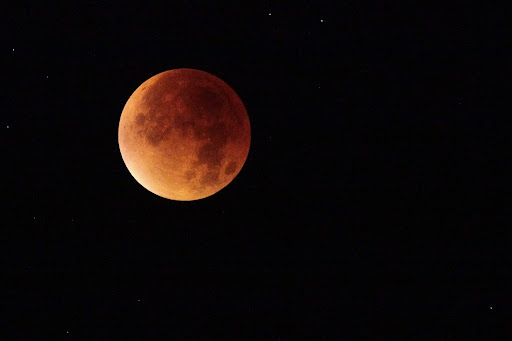
In the past, people generally thought that eclipses – both the lunar eclipse and solar eclipse – were a bad omen. Different cultures had different views of it, but it was usually interpreted as a sign of disasters, apocalypse, and angry gods.
As time passes by, we finally have a better understanding of this natural phenomenon around us.
An eclipse occurs when one astronomical body is obscured by another. This happens when three or more bodies like the Sun, Earth, and Moon are aligned. The alignment of these bodies is called syzygy.
When the Sun, Earth, and Moon are in syzygy, the Sun or Moon seems to be blocked from our line of sight here on Earth. This event is called an eclipse. There are two types of eclipses: solar eclipse and lunar eclipse.
A solar eclipse occurs when the Sun is obscured from our line of sight. On the other hand, a lunar eclipse occurs when the Earth blocks sunlight from reaching the Moon. As a result, the Moon looks dimmer.
Solar Eclipse vs Lunar Eclipse
A syzygy is the alignment of the Sun, Earth, and Moon. It occurs during two phases of the Moon: New Moon and Full Moon.
On a New Moon, the Moon is between the Earth and the Sun.

A solar eclipse takes place on a New Moon. During this time, the Moon directly blocks the Sun from reaching Earth. This causes momentary darkness to occur. Also, since the Moon and Sun are on the same side of the Earth, a solar eclipse happens during the day.
On a Full Moon, the Earth is between the Moon and the Sun.

We know that the Moon does not make its own light. It only seems to shine in our night sky because of the light that it reflects from the Sun. During a syzygy in a Full Moon, however, the Earth blocks sunlight from reaching the Moon. When this happens, a lunar eclipse occurs.
Generally, there are four eclipses in a year: two solar eclipses and two lunar eclipses. Between the two, more people can observe a lunar eclipse because the Earth casts a bigger shadow on the Moon. It can also last up to hours, compared to a solar eclipse which is usually just minutes long.
Aside from that, there is no need to use eye protection when viewing a lunar eclipse. Observing it with the naked eye will cause you no harm!
What Is a Lunar Eclipse?
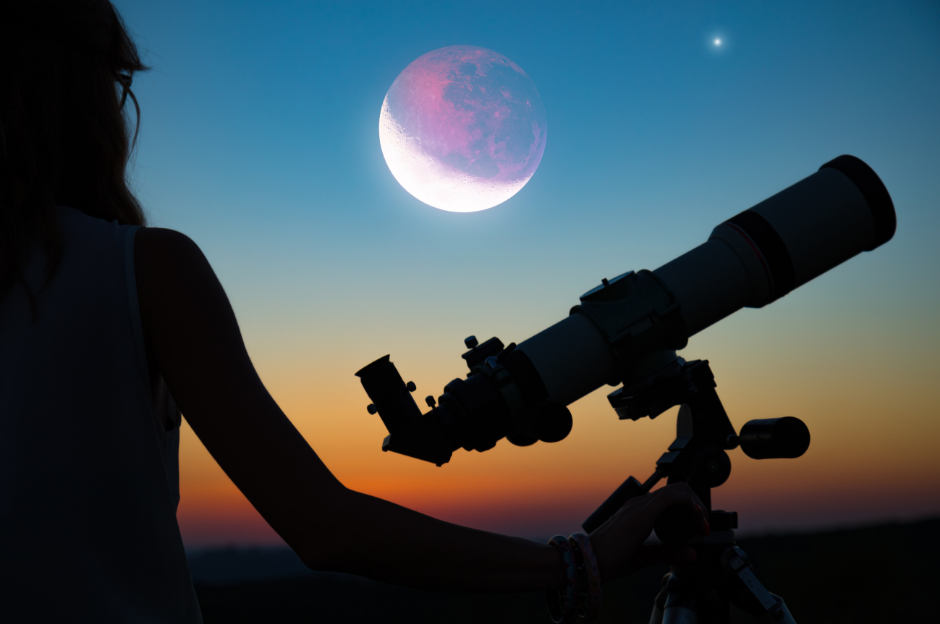
A lunar eclipse happens when the Earth gets in the way between the Moon and the Sun. When they are perfectly aligned, in syzygy, the Earth keeps direct sunlight from reaching the Moon. As a result, the Moon is eclipsed and it becomes dimmer.
When talking about lunar eclipses, we also often hear about solar eclipses. The main difference between the two is that in a lunar eclipse, the Earth blocks sunlight to the Moon. The opposite happens in a solar eclipse wherein the Moon blocks sunlight from reaching Earth.
Between the two, lunar eclipses are easier to observe. When it happens, it is visible to a larger portion of the Earth, or anywhere on the night side of Earth. It lasts longer too compared to a solar eclipse.
Solar eclipses are rather rare because the smaller shadow of the Moon only blocks a small portion of the Earth. While lunar eclipses are visible from half the globe, solar eclipses are specific to locations only. You have to be on the path of totality to be able to see a total solar eclipse.
Below are the projected solar eclipse paths from 2021 to 2040.
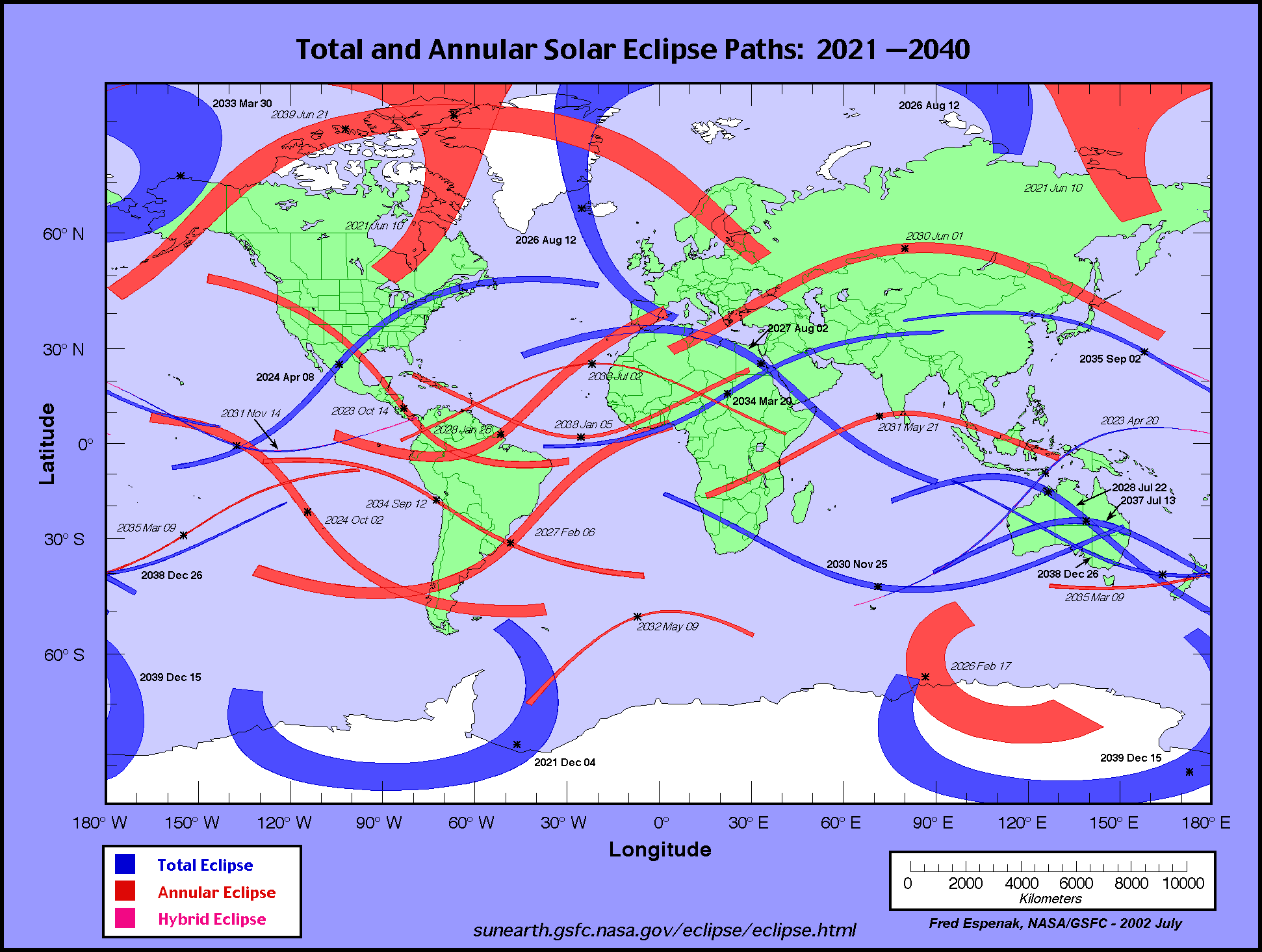
A lunar eclipse occurs on a Full Moon, but there is no lunar eclipse every Full Moon. The Moon’s inclined orbit can bring it above or below the Earth’s plane. As a result, it does not pass through the Earth’s shadow and no eclipse takes place.
Among the three types of lunar eclipse, the total solar eclipse is perhaps the most exciting. Though the Moon does not disappear during this event, it will have a reddish glow. When this happens during perigee, when the Moon is closest to the Earth, the reddish Moon appears bigger than usual. We call it a Super Blood Moon.
Earth’s Shadow: Umbra, Penumbra, and Antumbra
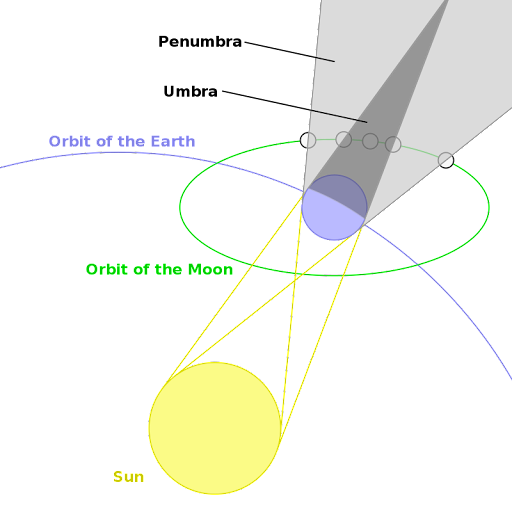
The Earth casts two types of shadows during a lunar eclipse: umbra and penumbra.
The central portion of the shadow is called the Earth’s umbra. This is the point where direct sunlight is totally blocked from the Moon. When the Moon is in the Earth’s umbral shadow, it becomes significantly dimmer.
The penumbra is like the partial shadow of the Earth. It only blocks part of the sunlight, and some still reach the lunar surface. The Moon only dims a little when it is in the Earth’s penumbral shadow.
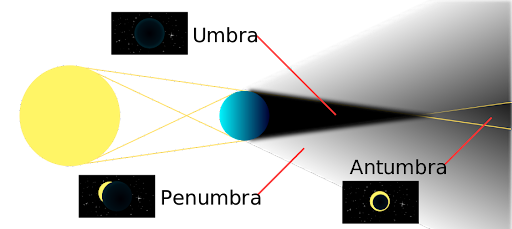
The third type of shadow is called an antumbra. This shadow extends past the umbra. The Earth’s antumbra is beyond the orbit of the Moon so it does not affect the lunar eclipses. Because of that, there is no annular lunar eclipse.
The different types of lunar eclipses are determined based on the Moon’s position in the umbral or penumbral shadow.
Different Types of Lunar Eclipse
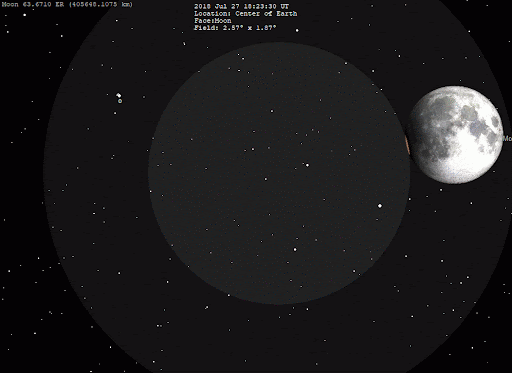
Each type is determined by its position in the path it takes through the Earth’s shadow. These types come at different stages as the Moon moves along this path.
In a total lunar eclipse, the Moon’s first contact with the shadow starts with a penumbral eclipse. As the Moon progresses, it is followed by a partial eclipse. When it is finally in the umbral shadow, a total eclipse occurs. After that, it will go back to being a partial eclipse, and finally, a penumbral eclipse.
Penumbral Lunar Eclipse
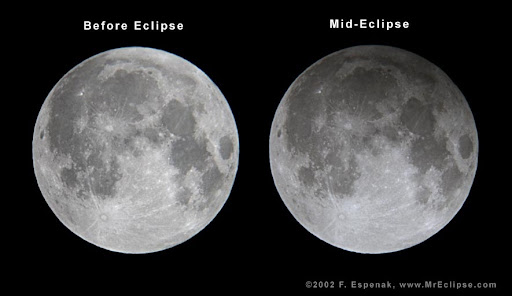
Penumbral eclipses make up one-third of all lunar eclipses.
A penumbral lunar eclipse occurs when the Moon is in the penumbral shadow of the Earth. There is not much change in the Moon’s appearance during this stage. It dims only a little and the change is not very noticeable.
Since no dramatic change happens to the Moon, most people do not notice an eclipse at all. It often appears just like any regular Full Moon.
There are two types of penumbral eclipses: partial and total. In a partial penumbral lunar eclipse, only a portion of the Moon is in the penumbral shadow. There is almost no change in the Moon’s appearance.
In a total penumbral lunar eclipse, the entire Moon is already in the Earth’s penumbral shadow. The Moon can turn slightly darker at its maximum but this change is also not very striking.
Partial Lunar Eclipse
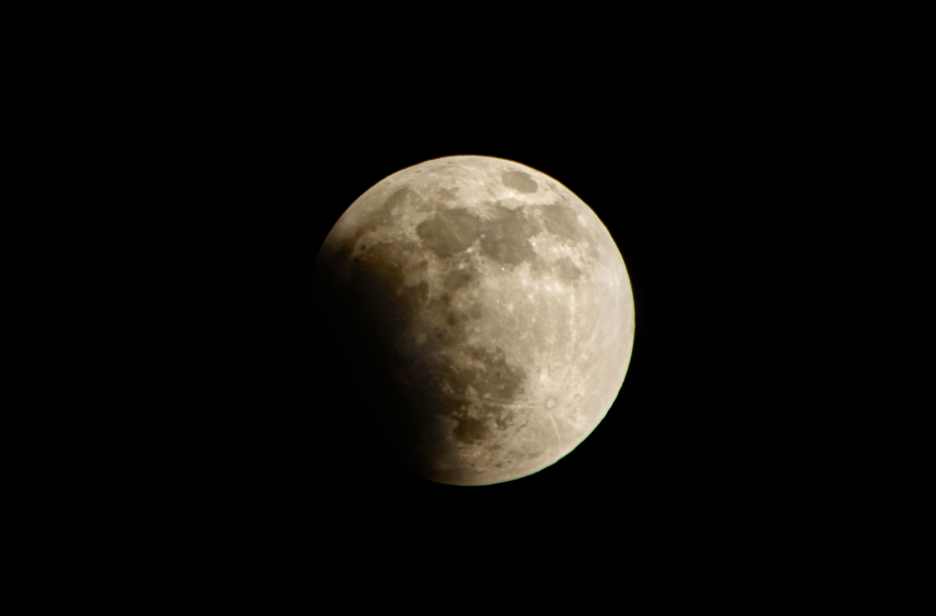
A partial lunar eclipse occurs when a portion of the Moon is in the umbral shadow of the Earth. The rest of it, however, is still in the penumbra. The umbra is the darkest and central part of this shadow where direct sunlight is totally blocked.
The part that is in the umbra becomes significantly darker than the rest of the Moon. As such, we can easily notice this eclipse when it happens. We can just see it with the unaided eye, there is no need for telescopes and other equipment.
Total Lunar Eclipse
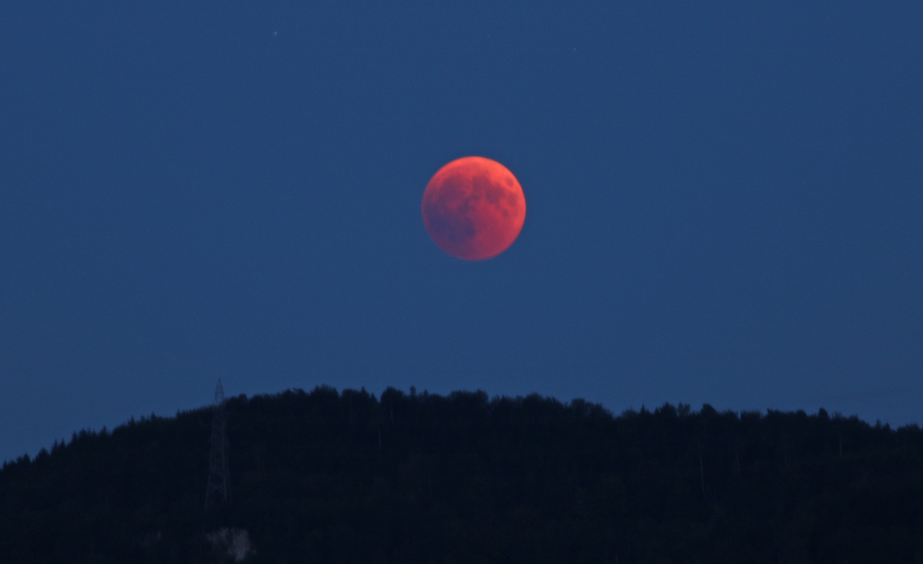
A total lunar eclipse occurs when the Moon is fully in the umbral shadow of the Earth. Even at maximum eclipse, the Moon does not become totally invisible during a total eclipse. Why so?
The reason for this is that even though direct sunlight is blocked, a bit of sunlight bends in the Earth’s atmosphere and reaches the Moon’s surface, and lights it up.
There is light scattering that happens in the atmosphere, leaving only the color with longer wavelengths—red light. This is why a total eclipse looks reddish, earning it the nickname “Bloodmoon.”
Aside from the common red hue, eclipses can also appear yellow, orange, or even brown. This depends on the kinds of dust particles in the Earth’s atmosphere that scatters the sunlight.
Four total lunar eclipses are called “tetrads.” A total lunar eclipse is very noticeable with its reddish color. There is no need to use any optical equipment to see it. Generally, 29% of all lunar eclipses are of this type.
A Lunar Eclipse Occurs at Full Moon
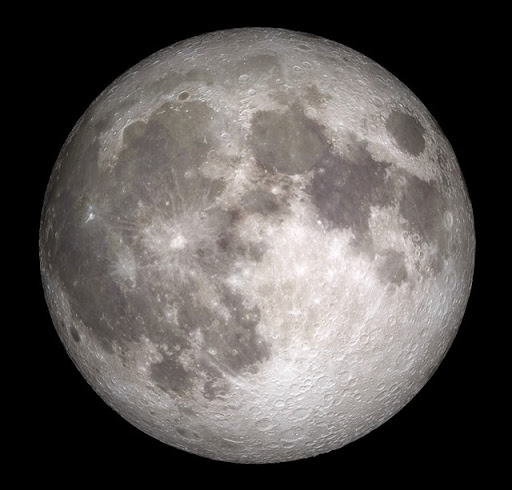
These events can only occur if two conditions are met. The first is that it should be a Full Moon. The second is that the Sun, Moon, and Earth should be in a straight line. This way, if these three bodies are perfectly aligned, Earth’s shadow will fall on the Moon.
A Full Moon rises after the Sun sets because these two objects are on the opposite side of the Earth. This means that we can only see a lunar eclipse at night.
In contrast, a solar eclipse, which takes place during the new moon phase, occurs in daylight. During the New Moon phase, the Moon and the Sun are on the same side of the Earth. They rise above the horizon together and also set at the same time. That said, a solar eclipse only occurs during daylight.
Our Moon travels in an elliptical orbit. The closest point of this orbit to Earth is called the perigee and the farthest point is the apogee. Sometimes, a Full Moon can appear bigger and smaller than usual when it is at these points.
Super Moon and Micro Moon
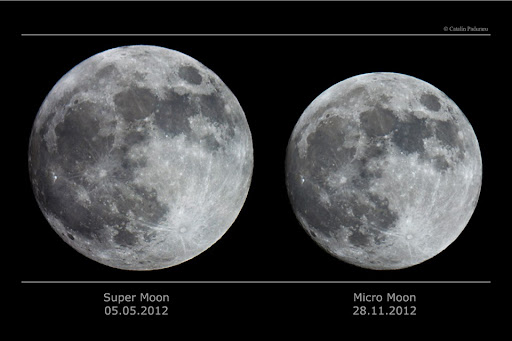
A Supermoon is a Full Moon near or at the perigee. Since it is closer, it appears considerably larger and brighter. Experts call it a “Perigean Full Moon.”
A micro moon, on the other hand, is the opposite of a Supermoon. The Moon is at apogee this time, so it looks smaller and dimmer as observed from Earth. This is called an Apogean Full Moon.
Sometimes, an eclipse happens when a Full Moon is at perigee. Aside from a larger Moon, the eclipse also makes it reddish. People call this exciting event a Super Bloodmoon.
Why is there no lunar eclipse every Full Moon?
There is no lunar eclipse every month because the Moon follows an orbit that is inclined by 5 degrees to the ecliptic. The ecliptic is the orbital plane of the Earth as it goes around the Sun.
The Earth and the Moon’s orbital planes meet at two points called the lunar nodes. When a Full Moon is at or near these lunar nodes, an eclipse occurs. When a Full Moon occurs away from these nodes, the Moon is either above or below the Earth’s shadow. As a result, no eclipse occurs.
Safe To See With the Naked Eye
With or without eclipses, looking directly at the Sun is always dangerous for the human eye. It can cause retinal burns which can lead to blindness.
People might think that it is safe to look at the Sun during a solar eclipse because it is blocked by the Moon. Even if it is partially covered, the Sun is still very bright and its light can still cause damage. Also, a total solar eclipse only lasts for a maximum of 7 minutes, and looking at it is still unsafe.
People should use protective glasses and filters to observe the solar eclipse. Indirect viewing is also advisable.
Not all eclipses, however, are harmful to the naked eye. Observing lunar eclipses is much easier. There is no need to buy solar glasses as we can see them safely with the naked eye. Even at its brightest phase, at Full Moon, the Moon is still 400,000 times less bright than the Sun.
In Myths and Culture
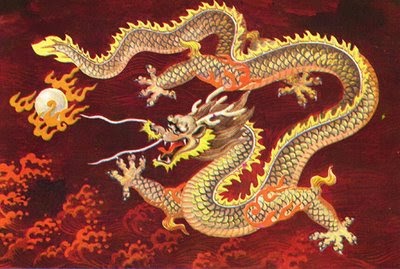
Different cultures have different myths and stories about the eclipse, especially when the Moon turns into a blood-red color.
The Incas thought that the red moon was caused by a jaguar that ate the Moon. They try to make noise and bring their spears and weapons out to drive this jaguar away.
Similarly, in other Chinese cultures, people believed that a dragon would devour the Moon or Sun during eclipses. Because of this, the people would make noises by beating their pots and drums to drive away the dragon.
In ancient Mesopotamia, it was believed that seven demons were attacking the Moon, causing a lunar eclipse. They also believed that the Moon represented their king, and an attack on it would mean an attack on the king.
During a lunar eclipse, a substitute king will take the place of the real Mesopotamian king. That temporary king will then disappear after the eclipse. Historians believed that this was done by poisoning the said replacement.
Not all cultures, however, viewed lunar eclipses as a bad thing. In some places in West Africa, there is a myth that eclipses are caused by the Sun and Moon fighting against each other. This story is viewed as a time to resolve conflicts and misunderstandings.
The Luiseño tribe interpreted the lunar eclipse as a sign that the Moon was sick. Because of that, they sing chants to say their prayers to restore it to health.
More Lunar Eclipse Facts
- The word “eclipse” has Greek origins. The Greek word for it was “ekleipsis,” which was adopted by the Latin and became “eclipsis.” The Greek word literally means “to fail to appear.”
- In March 1504, Christopher Columbus used his scientific knowledge to predict a total lunar eclipse. He used this opportunity to persuade the natives of Jamaica to continue giving food supplies to him and his crew.
- We can determine how dark a lunar eclipse is through the Danjon scale. This is a 5-point scale that rates the darkness of the lunar eclipse from 0 to 4. The darkest is given 0 ratings and the brightest is given 4.
- You can also witness the lunar eclipse if you were to stand on the Moon. During this time, you cannot see the Sun because it is blocked by the Earth. What you will see is a dark Earth that has a reddish-orange ring around it. This ring is caused by the scattering of light in the Earth’s atmosphere.
- A rare phenomenon called selenelion occurs when the Moon and the Sun can be seen in the sky at the same time during a lunar eclipse. They will be positioned near the horizon in different areas of the sky. The event takes place roughly once every 30 years.
- So far, the longest eclipse in the 21st century occurred on July 27, 2018. It was a total lunar eclipse that lasted 103 minutes or more than 1.5 hours. It was visible in most parts of Asia, Australia, Africa, South America, and Europe.
- The longest partial lunar eclipse in more than 500 years occurred in November 2021. Nicknamed “almost total” lunar eclipse by NASA, it lasted for nearly 3.5 hours. It was seen from around Thursday night up until early Friday morning.
- The Moon is moving away from the Sun by around 1.6 inches per year. Because of that, there will be no more total solar eclipses in the far future. It will also change how the Earth’s shadow will affect the Moon.
Sources:
(https://eartheclipse.com/space/amazing-facts-about-lunar-eclipse.html)
Image Sources:
What is an eclipse: https://storage.needpix.com/rsynced_images/blood-moon-2428965_1280.jpg
Solar eclipse: https://spaceplace.nasa.gov/eclipses/en/solar-eclipse.en.png
Lunar eclipse: https://spaceplace.nasa.gov/eclipses/en/lunar-eclipse.en.png
Solar eclipse paths: https://eclipse.gsfc.nasa.gov/SEatlas/SEatlas3/SEatlas2021.GIF
Umbra and penumbra: https://upload.wikimedia.org/wikipedia/commons/thumb/e/ec/Geometry_of_a_Lunar_Eclipse.svg/800px-Geometry_of_a_Lunar_Eclipse.svg.png
Umbra, penumbra, antumbra: https://upload.wikimedia.org/wikipedia/commons/thumb/0/0d/Umbra01.svg/924px-Umbra01.svg.png
Types of lunar eclipse: https://upload.wikimedia.org/wikipedia/commons/6/6c/Animation_July_27_2018_lunar_eclipse_appearance.gif
Penumbral lunar eclipse: https://www.mreclipse.com/LEphoto/NLE2002/image/NLE2002-3w.JPG
Full Moon: https://upload.wikimedia.org/wikipedia/commons/thumb/1/10/Supermoon_Nov-14-2016-minneapolis.jpg/800px-Supermoon_Nov-14-2016-minneapolis.jpg
Supermoon vs Micromoon: https://apod.nasa.gov/apod/image/1611/supermicromoon_paduraru_960.jpg
In myths and culture: https://i0.wp.com/woay.com/wp-content/uploads/2017/08/dragon.jpg?w=400&ssl=1